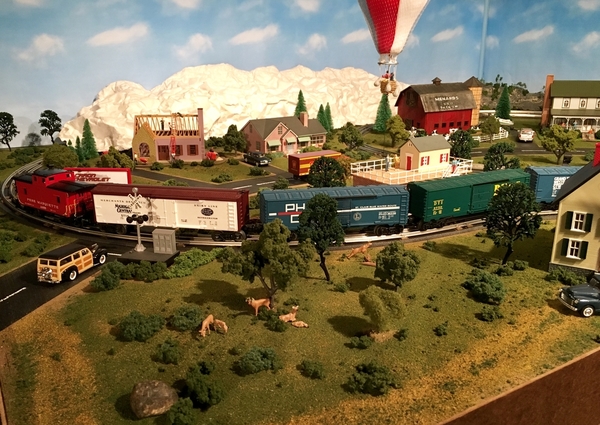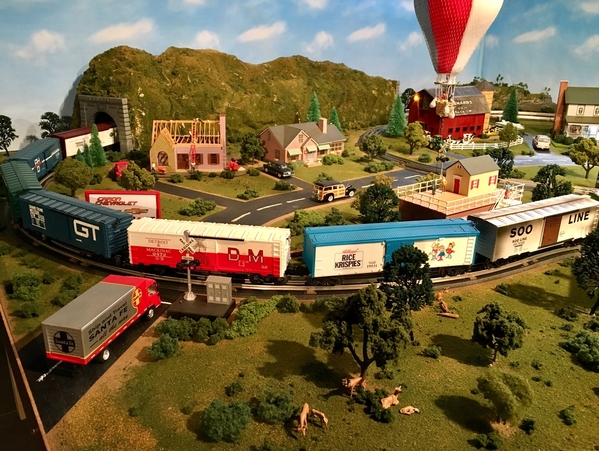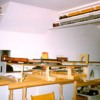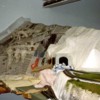So I have just completed laying track and building plywood/foam superstructures on my new layout. Now its time to start thinking scenery and more specifically mountain/tunnel building. I am planning on using WS shaper sheets and their plaster to form the mountain shells themselves. Now, for the rock faces I am heavily leaning towards Bragdon Enterprises rock molds (#87 and a mix of smaller molds). My goals are realism and ease of production which I know don't go hand in hand; especially the Bragdon rock making process seems a little time consuming. However, I am thinking the shaper sheet should save considerable effort from having to weave cardboard strips and then create a hardshell over it. Please let me know what you think of this approach in terms of potential realism in the end and ease of production.
Replies sorted oldest to newest
Hadn't heard of the Shaper Sheet yet. Did a quick search and took a look at it. Sounds pretty interesting. It should speed mountain and terrain building up considerably from the looks of it. Also looks a little pricey, but if you don't need a lot of it, probably not a problem.
Want a quick tip on plaster cloth? Instead of dipping the cloth in water and laying it in place like they tell you to do in the instructions, in a lot of cases you can lay it on dry. Then mist it with some water in a spray bottle. A lot less messy this way.
Rock molds are rock molds, they pretty much are what they are. They're all a little time consuming, but usually always look really good when done.
Good luck, be sure and post some pictures during the process. ![]()
I watched a video the other day where a guy took some aluminum window screen, crumpled it up and then spread it out to form the basic shape he wanted. He then took toilet paper and dabbed diluted white glue on it placed on the screen. It turned out pretty good and was much faster than the strip method. I'm going to try it.
Thanks for the replies guys. MF (no offense), great tip on the plaster cloth although I may just use the spreadable plaster on the shaper sheet since it seems easier than cutting the sheets to size but may be messier. I really have no experience with rock molds (or any of this...) but the Bragdon process seems harder that most since it is essentially a 3 part drying process where you need to create the release agent from petrol jelly/spraypaint let it dry, make a layer of hard shell in the mold let it dry, and then make the foam itself which also has a working time in which the rock needs to be applied to the layout.
However, the results I have seen from their molds is the look I am going for. More of a "clean rock" look rather than a blasted crumbly mess of outcropping. In fact, I am really trying to model rock similar to the laidoffsick layout where he did an excellent job of capturing clean granite sheets. I have been an avid rock climber for about 17 years so rock quality is a priority ![]() .
.
PP (no offense), the aluminum window screen idea would most likely be the equivalent of shaper sheet but much cheaper. It also brings along the concern of interference with the Legacy signal much like the shaper sheet. However, since my mountains will be open on the backside for access (and lack of viewing angle...) I *think* it shouldn't pose an issue. I am excited to try all of this but also don't want to waste a metric butt ton of time and materials at the outset so thanks for your suggestions guys. I will probably try it out on some scraps before fully committing but we all know how plans can change when it comes time to bake the cake ![]()
patternpilot posted:I watched a video the other day where a guy took some aluminum window screen, crumpled it up and then spread it out to form the basic shape he wanted. He then took toilet paper and dabbed diluted white glue on it placed on the screen. It turned out pretty good and was much faster than the strip method. I'm going to try it.
I just saw the same video and wondered if that material he used is actually replacement aluminum screen, like the stuff sold in rolls at Home Depot, or something else they sell in Europe because it seemed much thinner, more pliable and easier to cut than what I saw on the shelf. The guy in the video called it "mesh" at one point and "net" at another. I even posted the question at the bottom of the YouTube video but the guy hasn't responded yet. I would think screen is screen, even in Europe. I also hadn't thought about it interfering with the signal from a LC+ remote. I'm at the same point in my layout...a lot of mountains/elevation changes over L-Girder open benchwork to deal with scenery-wise and am mulling over all the choices. I don't think I would do the toilet paper soaked in white glue though. I've got a lot of paper shop towels that I already bought. I'm thinking towel soaked in Structolite over cardboard web is probably the most economical way to go, but messy.
The Shaper Sheet looks like it could work very well, but if you have a lot of area to cover like I do, it could get expensive.
If you are considering trees on top of your mountains you may want to use stacked foam board to create your mountains. I've used plaster with mesh sheets in some spots on my layouts which created great mountains but when I added trees it was very difficult to secure them in a straight position. Once the plaster shell is punctured by the base of the tree the trees tend to tilt unevenly which drives me a little crazy. Foam board they pop right in nicely.
xrayvizhen posted:patternpilot posted:I watched a video the other day where a guy took some aluminum window screen, crumpled it up and then spread it out to form the basic shape he wanted. He then took toilet paper and dabbed diluted white glue on it placed on the screen. It turned out pretty good and was much faster than the strip method. I'm going to try it.
I just saw the same video and wondered if that material he used is actually replacement aluminum screen, like the stuff sold in rolls at Home Depot, or something else they sell in Europe because it seemed much thinner, more pliable and easier to cut than what I saw on the shelf. The guy in the video called it "mesh" at one point and "net" at another. I even posted the question at the bottom of the YouTube video but the guy hasn't responded yet. I would think screen is screen, even in Europe. I also hadn't thought about it interfering with the signal from a LC+ remote. I'm at the same point in my layout...a lot of mountains/elevation changes over L-Girder open benchwork to deal with scenery-wise and am mulling over all the choices. I don't think I would do the toilet paper soaked in white glue though. I've got a lot of paper shop towels that I already bought. I'm thinking towel soaked in Structolite over cardboard web is probably the most economical way to go, but messy.
The Shaper Sheet looks like it could work very well, but if you have a lot of area to cover like I do, it could get expensive.
I wouldn't worry about a LC+ signal since it uses bluetooth. The Legacy signal is a whole different beast that relies on earth ground. I am not too concerned since the mountain will be open in the back plus I can ground a big sheet of the shaper material if needed. The cardboard approach, although tried and true as well as economical, just seems like a tedious arts and crafts project that I am not interested in undertaking.
Gerry posted:If you are considering trees on top of your mountains you may want to use stacked foam board to create your mountains. I've used plaster with mesh sheets in some spots on my layouts which created great mountains but when I added trees it was very difficult to secure them in a straight position. Once the plaster shell is punctured by the base of the tree the trees tend to tilt unevenly which drives me a little crazy. Foam board they pop right in nicely.
Hmm, I will definitely have some trees. Maybe its better to hot glue them instead of puncturing using the bottom spike to get them upright on the mountain surface?
The old-school substitute for screening is chicken wire. Works fine and is extremely inexpensive. Just protect whatever is under it from the drips. Unless you are doing something very subtle, paper towels are a better covering choice than toilet paper, IMO.
You are correct that hot-glue is a solution to the "droopy trees" problem. You can use it to build up the flailed bottom of the trunk. You do have to make sure the mountain is stiff enough so the whole thing doesn't buckle, though.
I used the Shaper Sheet product to form this mountain and tunnel. Because it was just static...the plaster overcoating wasn’t necessary for this application.
One sheet of the larger Shaper Sheet was first roughly formed for placement:
Next the final shape was made and tunnel openings were added:
Finally the landscaping material was added:
There are no trees on the mountain...however, there is a small camping scene that has been added since this photo was taken. If adding trees, guessing that the plaster overcoating would been needed for added strength. The sheet here was sufficient in this application to form the mountain and cover the track forming a tunnel...the whole sheet is just a facade with the back being open and the top edge leaning against the background.
Attachments
PDDMI posted:There are no trees on the mountain...however, there is a small camping scene that has been added since this photo was taken. If adding trees, guessing that the plaster overcoating would been needed for added strength. The sheet here was sufficient in this application to form the mountain and cover the track forming a tunnel...the whole sheet is just a facade with the back being open and the top edge leaning against the background.
One could simply add puff ball trees or large chunks of ground foam to effectively add "trees" to the mountain. No tree trunks or poking holes for same. Give it a try, I think it would look pretty good. ![]()
patternpilot posted:I watched a video the other day where a guy took some aluminum window screen, crumpled it up and then spread it out to form the basic shape he wanted. He then took toilet paper and dabbed diluted white glue on it placed on the screen. It turned out pretty good and was much faster than the strip method. I'm going to try it.
PatterPilot
One thing to be careful with using Aluminum or any metallic screening. If your layout plans on using command control, either DCS or Legacy. Make sure the metallic screening is grounded otherwise you can expect some level of interference with the signals. We had that issue at my clubs previous location and when we rebuilt we used Latticed cardboard and plaster cloth which works much better. Hope this helps
L.I.TRAIN posted:patternpilot posted:I watched a video the other day where a guy took some aluminum window screen, crumpled it up and then spread it out to form the basic shape he wanted. He then took toilet paper and dabbed diluted white glue on it placed on the screen. It turned out pretty good and was much faster than the strip method. I'm going to try it.
PatterPilot
One thing to be careful with using Aluminum or any metallic screening. If your layout plans on using command control, either DCS or Legacy. Make sure the metallic screening is grounded otherwise you can expect some level of interference with the signals. We had that issue at my clubs previous location and when we rebuilt we used Latticed cardboard and plaster cloth which works much better. Hope this helps
Thanks, I didn't think if this when I considered using this technique. I'll be using DCS and conventional and thinking that the signal goes to the WiFi then the TIU I never thought there could be interference from the metal cloth. Good information.
Doug, You might want to review this thread I put up from 2017 about "easy to make hills and mountains" with Low Loft Batting and Expanding Foam . I found the method on line, then added my own "twist" with the expanding foam. Have made all my hills, and mountains this way for the past 2 years, both with and without rock castings.
Here is a link: I have also added another Youtube video since these were done.
https://ogrforum.ogaugerr.com/...m-and-fabric-batting
This second link has the last section I did in early September of this year,
I stacked up layers of extruded pink foam in 1 and 2-inch thicknesses to build hills and tunnels on two layouts. A sheet of foam is inexpensive, easy to cut into a rough shape, and lightweight. Position your tunnel portals, then use vertical pieces of foam for the tunnel walls and horizontal pieces for the tunnel roof. Stack foam along the tunnel sides and above the tunnel roof to create the contours of the hill, apply a layer of plaster onto the foam and add rock molds as you prefer. Finish the visible interior walls of the tunnel so that they appear realistic when looking in through the portals. I used commercially available "cut stone" walls for the visible interior walls.
MELGAR
I've had luck with using some left over roofing tar paper to shape my mountains. I then proceed with plaster cloth. To plant my trees, I drill a 1/8 hole and fill with liquid nails. Plant the tree in the glue and wait to dry.
Wow, thanks for all of the good input, quite a few methods lined out here. I just ordered supplies from scenic express and bragdon and will keep everyone updated on progress.
So here is a rather large update that shows the progression of building a mountain (still a plateau at this point). The shaper sheet is great and a big time saver vs. fooling around with cardboard strips. Really the only downside is it gets expensive and for that reason the SS will not be used to complete the mountain top and instead I will be using a chicken wire structure. The plaster that Woodland Scenics sells to put on the shaper sheet sets up fast so you had better be masked and prepped once you mix it. The rocks that the Bragdon Enterprise kit makes have exceeded expectations; the pictures don't do it justice. They are incredibly lifelike. Also, the process of making the rocks isn't too bad once you get into the swing of things but you do need to be attentive to mixing instructions and curing times. For reference the rock seen here took about 60-70% of the materials provided in the 1lb starter kit they sell and I have since ordered more of the satin and foam resins. I definitely still have some work to do blending the mountain into the base and touching up some areas but at least you should get an idea of what the end result will be. As always comments and questions welcome.
Attachments
Great looking rocks!
Two questions:
- Is there any kind of smell to the Bragdon Ent. resin or other chemicals that are used?
- What size Shaper Sheet did you use and how many? I've got a similar type/size of multi-layered mountain as you.
xrayvizhen posted:Great looking rocks!
Two questions:
- Is there any kind of smell to the Bragdon Ent. resin or other chemicals that are used?
- What size Shaper Sheet did you use and how many? I've got a similar type/size of multi-layered mountain as you.
xray, there is zero smell to the rocks themselves however, spraypaint (read outdoor/garage only) must be used to prep the mold before casting the rocks. The resins and the finished rock have zero odor which is kind of nice.
I am on my third roll of 18" x 72" shaper sheet and could see going into a fourth (mountain is currently 17" tall). The layout is small at 8' x 11.5' so the mountain and two reversing loops was kind of a must to get a decent loop time. The mountain grade itself ends up being a little over 30' of track and then the top level reverse loop adds another 12-15' which allows for some run time.
Impressive!
Attachments
I used foam rock faces sold by Scenic Express. I cut the rectangular stock into thinner random shapes and attached and blended it to the mountain with Gypsolite. If you cut it thin enough, you can bend it too. Worked great for me. Saved a lot of time and mess. No problem painting/finishing over the form.
I really like the vertical build up and bridge to the plateau on this layout. ![]()
A bonus puppet show too eh? ![]()
Looks great! The shaper sheets do a nice job as do the rocks.
Nice work, as always, guys. For 30 years, all my father and I ever used for mountains and hills was window screen, joint compound, and a staple gun.
Here is an example from the old attic layout.
For the latest table layout, I've used many ideas gathered from the guys on this forum.
This pic is of an older mountain build. Screen and joint compound. The top half was cut off to allow for the third and fourth levels. The rock faces are carved and painted foam from salvaged packaging material.
Foam, attached to a backing wood board, that attaches to a screen-made hillside. To fill in gaps, I used a lot of sculptamold with several rock molds, including crumpled aluminum foil for flatter faces.
This bottom corner section is the only surviving piece of my old attic layout. Screen, with some rock molds.
These last two are my solution to an extremely layout-limiting oil tank. This is screen and cardboard, the last pic shows one of those grass mats. Both are attached to a flat piece of old wall panel that sits on top of the tank.
I always try to think of ways to cover those pipes, especially with the World Trade Center twin towers. I've yet to find an adequate solution to that one.
Jerry
Attachments
Attachments
Wow, yet another good round of suggestions although I am pretty far down a path now... Many ways to skin this cat, I really am going for a lot of detail since these will be front and center of my layout. Besides continuing to build up the rock faces I also need to start weathering the tunnel portals which are unfortunately already in place. Luckily only 3 of 5 are visible but there seems to be a coating on the foam (Scenic Express portals) that prevents them from taking a wash. It may just be the foam isn't very porous or needs a dullcote, not sure. Thanks again for all of the suggestions and I really hope this thread is a good searchable archive for others to start from.
Of all the things we do for our hobby, mountain building can be the most onerous. It all depends on how big and how realistic you want the final result to be. I chose the cardboard strips, plaster-soaked-Bounty Towels method along with Bragdon molds mostly of sedimentary rocks. It is a very big structure and took a tremendous amount of effort to do it including rupturing my right upper biceps tendon using a staple gun at a funny angle. But it was very inexpensive. The only real cost was the plaster and the rock molds. I just collected lots of cardboard boxes and cut the strips on a paper cutter. I used hot glue to hold the strips together and the staple gun to hold the strips to the sub-structure which was wood. My entire method is show starting here on my 6-year build thread. Be my guest to review it and see if it works for you. It starts on page 34 of the thread.
https://ogrforum.ogaugerr.com/...e-pandampprr?page=34
You'll notice that even with all my careful thinking about overhangs and portal positioning, I was still wrong when I mounted one too close to the track center when it needed to be shifted to the left to give further clearance for overhangs. I had to field modify the portal opening with the Dremel to make it wide enough to clear the engines. If you have large equipment and there are curves involved, double check the positions and then carefully locate them and re-test.



























![20190102_081443[1] 20190102_081443[1]](https://ogrforum.ogaugerr.com/fileSendAction/fcType/0/fcOid/81819042994805772/filePointer/82100772910584392/fodoid/82100772910584383/imageType/MEDIUM/inlineImage/true/20190102_081443%255B1%255D.jpg)
![20190102_081627[1] 20190102_081627[1]](https://ogrforum.ogaugerr.com/fileSendAction/fcType/0/fcOid/81819042994805772/filePointer/82100772910584393/fodoid/82100772910584384/imageType/MEDIUM/inlineImage/true/20190102_081627%255B1%255D.jpg)
![20190102_081815[1] 20190102_081815[1]](https://ogrforum.ogaugerr.com/fileSendAction/fcType/0/fcOid/81819042994805772/filePointer/82100772910584394/fodoid/82100772910584385/imageType/MEDIUM/inlineImage/true/20190102_081815%255B1%255D.jpg)
![20190102_082043[1] 20190102_082043[1]](https://ogrforum.ogaugerr.com/fileSendAction/fcType/0/fcOid/81819042994805772/filePointer/82100772910584395/fodoid/82100772910584386/imageType/MEDIUM/inlineImage/true/20190102_082043%255B1%255D.jpg)
![20190102_082114[1] 20190102_082114[1]](https://ogrforum.ogaugerr.com/fileSendAction/fcType/0/fcOid/81819042994805772/filePointer/82100772910584396/fodoid/82100772910584387/imageType/MEDIUM/inlineImage/true/20190102_082114%255B1%255D.jpg)
![20190102_081443[1] 20190102_081443[1]](https://ogrforum.ogaugerr.com/fileSendAction/fcType/0/fcOid/81819042994805772/filePointer/82100772910584392/fodoid/82100772910584383/imageType/SQUARE_THUMBNAIL/inlineImage/true/20190102_081443%5B1%5D.jpg)
![20190102_081627[1] 20190102_081627[1]](https://ogrforum.ogaugerr.com/fileSendAction/fcType/0/fcOid/81819042994805772/filePointer/82100772910584393/fodoid/82100772910584384/imageType/SQUARE_THUMBNAIL/inlineImage/true/20190102_081627%5B1%5D.jpg)
![20190102_081815[1] 20190102_081815[1]](https://ogrforum.ogaugerr.com/fileSendAction/fcType/0/fcOid/81819042994805772/filePointer/82100772910584394/fodoid/82100772910584385/imageType/SQUARE_THUMBNAIL/inlineImage/true/20190102_081815%5B1%5D.jpg)
![20190102_082043[1] 20190102_082043[1]](https://ogrforum.ogaugerr.com/fileSendAction/fcType/0/fcOid/81819042994805772/filePointer/82100772910584395/fodoid/82100772910584386/imageType/SQUARE_THUMBNAIL/inlineImage/true/20190102_082043%5B1%5D.jpg)
![20190102_082114[1] 20190102_082114[1]](https://ogrforum.ogaugerr.com/fileSendAction/fcType/0/fcOid/81819042994805772/filePointer/82100772910584396/fodoid/82100772910584387/imageType/SQUARE_THUMBNAIL/inlineImage/true/20190102_082114%5B1%5D.jpg)


